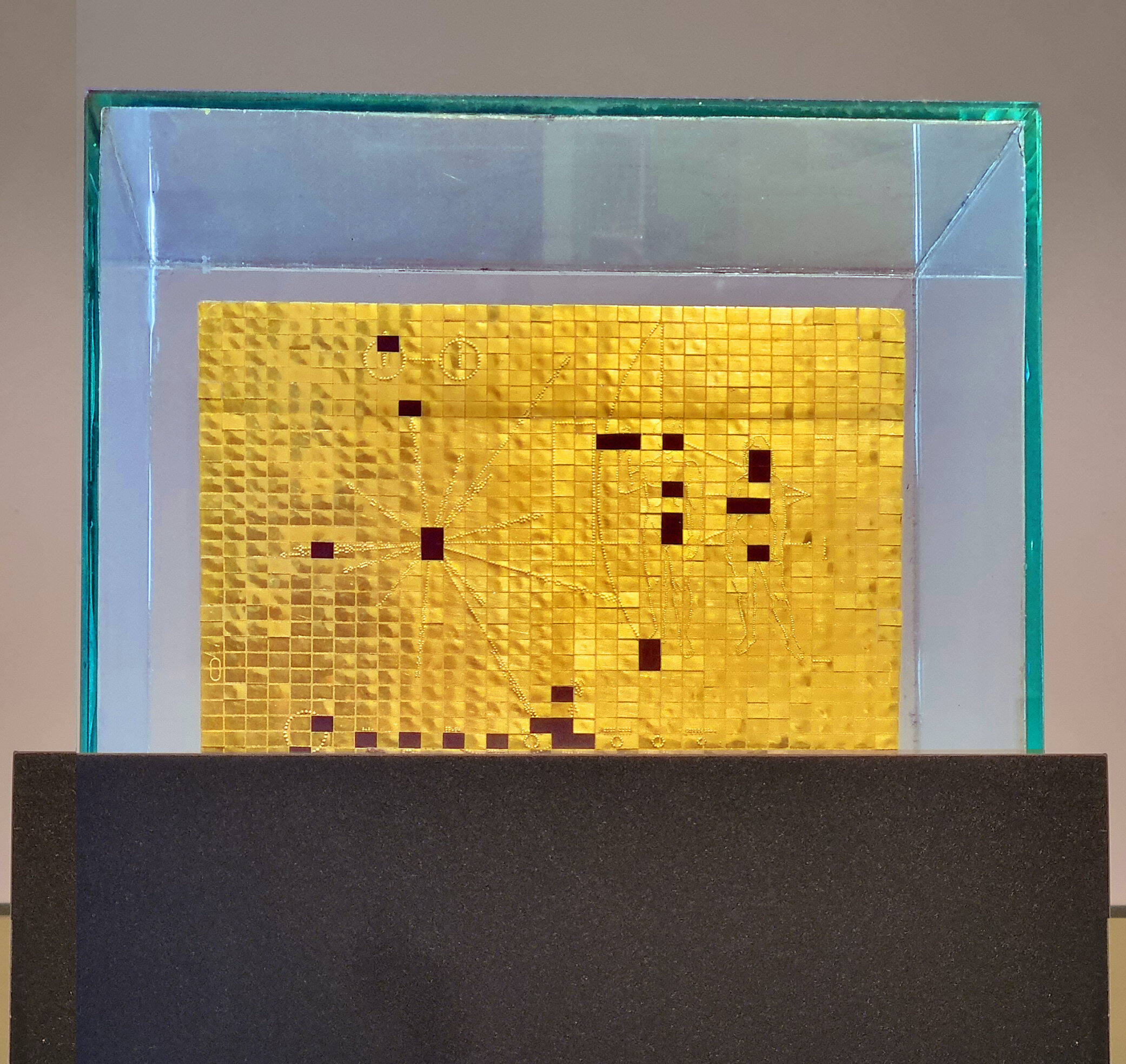Richard Kriesche

Artsat – Space _Message _Sculpture, 1991 (Detail)
Gold, acrylic glass, veneered wooden construction
22,5 x 31 x 190 cm
Courtesy the artist
The large multi-part project ART-SAT (1991), produced at the interface between art and science, is a good example of the trans-disciplinary practice of Richard Kriesche. ART-SAT was made in conjunction with the space flight of the first and to date only Austrian cosmonaut Franz Viehböck. This flight known under the name of Austromir 91 was undertaken in cooperation with the former Soviet Union. This collaboration was begun by professor Willibald Riedler from the Technical University of Graz, whose Institute for Space Research worked together with Russian scientists for many years. Viehböck’s space capsule was launched on October 2, 1991, and took him to the Soviet space station MIR on a mission lasting a total of eight days.
ART-SAT consisted of various elements and different venues: an exhibition in a hotel in central Graz, the Austrian broadcaster ORF studio in Styria, a ditch in front of the Styrian state television studio, a piano with additional technical devices, a CD, and a welding robot. From the Graz television studio Kriesche gave Viehböck his hand, using a newly developed satellite video conference system. This message was sent to Moscow and from then on to the MIR space station, where the waving hand appeared on a video monitor. During MIR’s ensuing orbit of the Earth, a multimedia action took place in the ORF studio and was broadcast on television, with live performances on the themes of art spaces, cultural spaces, and outer space, with Danube waltzes being played non-stop in the background. When MIR was above Graz, it sent a trigger signal in order to convey a text message.
Viehböck’s message was integrated into the music, thus making it sound strange, and at the same time acoustic parameters were extracted by means of spectral analysis from this now altered Danube waltz and saved on a computer. The coded message was visualized on a specially prepared dumb piano, as if the imaginary hand of the cosmonaut were playing it. After a few minutes, the space station had departed the area around Graz where reception was possible, and then the data saved on the PC were processed by a robot that had been placed in front of the studio with the audience. This robot welded the coded message onto a stainless steel plate with a diameter of c. 3.5 m. This plate became an artwork entitled ASCII Heaven (1991), which has been on permanent display on Graz’s Schlossberg. ASCII stands for American Standard Code for Information Interchange, a sign language that was used for the transmission of the message. Placing this work on the hill up to the castle in Graz can be seen in the context of the history of this place — in the early years of Austrian radio broadcasting this was the location of an important radio station. During the entire duration of MIR’s orbit of the Earth, a ditch was dug in front of the Graz ORF studio, in order to make the duration of the orbit visible in spatial terms.
The work Artsat – Space_Message_Sculpture (1991), presented in HALLE FÜR KUNST Steiermark in this exhibition, was originally shown in a Graz hotel. It consists of a rectangle made of small metal plates, derived from one single metal plate that was divided into pieces after having the silhouettes of a woman and a man engraved into it. On the rear of all of the smaller plates, a pin was affixed, like those used for earrings. This artwork was thus an assembly of items of jewelry, and visitors were permitted to take pieces home. With this element of his ART-SAT project, Kriesche wanted to establish a connection between the story of the Argonauts from Greek mythology and the space traveler in the year 1991. The Argonauts were seafarers who wore a ring in one ear by way of identification. The artist used this associative connection between Greek mythology and contemporary affairs to create a participatory work that was less determined by science and technology than the other elements of his project, but rather based on humor and anecdotal knowledge.
The way in which the artist designed a system of different but co-dependent human and non-human protagonists already in the early 1990s is a good reflection of his own view of the world. One of the most fascinating premises of our present day rests on the notion of post-humanism, which assumes that not only human protagonists but also technologies, substances, and artefacts have agency and the power to take action. At the same time the work ART-SAT (1991) can also be seen in terms of the here and now as a model for an immaterial network of different points of reference, operating in ways similar to the internet. Here different servers are in contact with each other across geographical borders, even linked up via satellites, forming a network that contains emotions and actions. Just like the Argonauts explored the ocean searching for something new, we surf through the internet and come across not just useful information and services, but are also often surprised by unproductive errors that might have bizarre consequences.
Artsat – Space_Message_Sculpture, 1991
Gold, acrylic glass, veneered wooden construction
22,5 × 31 × 190 cm
Courtesy the artist
Richard Kriesche
is an artist, art and media theorist. His artistic fields of work include photo art, video art, computer art, net art, installations, performance and multimedia art. In his works, Kriesche attempts to bridge the gap between the genetic micro-worlds and the macro-worlds of the universe. With his sculptures and installations, Kriesche has been at numerous major events such as documenta 6; the Venice Biennale; and in museums such as the Haus der Kunst; Munich, and the Chicago Art Institute. Most recently, the Museum der Moderne in Salzburg dedicated an extensive survey exhibition to him.